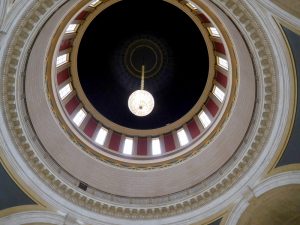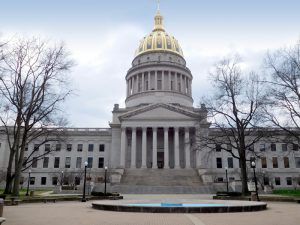The historic inner dome and the interior supporting walls of the West Virginia State Capitol Building were found to have structural deficiencies. Using 3-D finite element analysis modeling and laboratory testing to determine material properties for the unique coconut fiber reinforced plaster elements, repairs were designed to strengthen portions of the existing building and incorporate supplemental supports to preserve the integrity of this important structure. Additionally, it was necessary to support the dome in-place while the walls beneath the dome were removed entirely and rebuilt.
The West Virginia State Capitol Building was constructed in 1932 and is a steel-framed structure with masonry infill, interior plaster finishes, exterior limestone, and a 292-foot-tall gold leaf gilded dome. The building features an inner dome that is constructed of two shells. The outer shell is constructed of metal reinforced cementitious plaster and is attached to a steel grid with hangers that suspend it from a concrete deck. The inner shell is constructed with coffers that were individually cast with gypsum plaster and coconut fiber reinforcement and attached to the framing grid for the outer shell using plaster wads reinforced with coconut fiber.

In some locations, the coconut fiber wads had begun to fail. There was also cracking observed within the lower portions of the inner shell. The clay tile walls beneath the inner dome that were intended to serve as furring for the interior plaster had displaced outward and upward through irreversible moisture expansion and had been laid in various orientations that compromised their structural integrity. Much of the inner shell’s weight was bearing on cracked clay tile walls, and the hangers for the dome had buckled.
Through structural modeling, the stresses within the existing dome were correlated to crack patterns and other failures. Laboratory testing of plaster samples containing coconut fiber reinforced gypsum from the interior rotunda was performed to determine key material properties for the analysis. At the inner shell, locations identified to have high stresses were retrofitted with glass fiber reinforced polymer (GFRP). This GFRP retrofit was also tested in a laboratory setting to evaluate the performance and increased strength of the composite system.
Stainless steel plates connected with wire ties were also installed as supplemental supports to connect the inner shell to the outer shell to compliment the coconut fiber reinforced wadding used during the original construction. The GFRP system was coated with a cementitious coating to offer fire resistance and mimic the appearance of plaster. A stand-alone mockup of the inner dome was constructed to work through constructability challenges before installing the components on the dome itself.

Many of the flat straphangers for the hanger system supporting the outer shell were buckled, and several of the concrete deck attachments were deficient. The repair design incorporated turnbuckles into each hanger such that the tension could be adjusted for each individual hanger. In-line data-logging load cells were installed at key locations such that the tension could be monitored during and after the retrofit process to ensure the loads within the hangers were properly distributed. This monitoring system will remain in place to provide a warning system if any of the loads become disproportionate.
Much of the inner shell’s dead load was bearing on the clay tile walls, which prevented them from simply being removed and replaced. A creative solution was developed to turn the cracked non-structural clay tile units into a reinforced horizontal bond beam element. The top two courses of existing clay tile would be grouted and reinforced to form a continuous beam around the base of the dome that would then be supported by new steel brackets connected to the main structural framing of the building. A detailed sequencing plan was developed that created redundancy in the support of the dome as the walls were completely removed from beneath the dome. First, slotted openings were made within the existing clay tile to insert the reinforcement and fully grout the outer cell of the existing clay tile. Once the bond beam was complete, discrete openings were made at each column to install the steel brackets; the reinforced clay tile beam was utilized to transfer the weight of the dome to the portions of the wall that remained. Finally, sections of clay tile were removed between brackets to install tube steel and angles to provide supplemental support below the clay tile bond beam. Flexibility was incorporated into the connections to the brackets using slotted holes and field welding to account for variations in the elevation of the bond beam and brackets. Once the steel framing was in place, all remaining clay tile was then removed.
This project presented many challenges. The coconut reinforced gypsum plaster required laboratory testing to determine properties for this unique material. Sequencing of the hanger re-tensioning, dome strengthening, and bond beam supports was necessary to maintain the dome in an equilibrium state without creating unbalanced stresses. Limited access and variability in existing conditions required coordination with the construction team and creative structural design to develop unique solutions.■
WDP & Associates Consulting Engineers, Inc was an Outstanding Award Winner for the West Virginia State Capitol Building project in the 2020 Annual Excellence in Structural Engineering Awards Program in the Category – Forensic/Renovation/Retrofit/Rehabilitation Structures under $20M.
